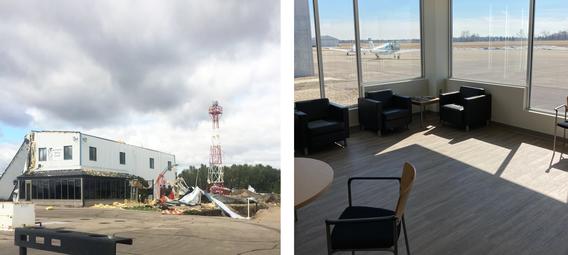Summer was just winding down in late September 2018 when a line of strong storms swept across southeastern Minnesota. Among the hardest-hit places was the Faribault Municipal Airport, which was struck by a category EF2 tornado hundreds of yards wide.
Located 50 miles south of the Twin Cities off I-35 between Northfield and Owatonna, Faribault is a community of almost 24,000. Its airport houses fixed-base operator Quality Aviation, an arrival/departure building, a maintenance hangar, city-owned T-hangars, and several private hangars. Operations on-site include a medical air ambulance service, a rare aircraft restoration outfit, an avionics company, and a glider operation.
The airport was originally located on the east side of town when it began operations in 1947. Faribault public works director Travis Block says the desire for an asphalt runway precipitated the airport’s move to the northwest part of the city sometime in the 1970s.
That upgrade resulted in “a lot of activity here, with aircraft constantly coming and going,” says Block. “Our airport sees a real mixture of traffic, especially for one of its size.” In addition to the asphalt runway, the airport also has a turf strip.

According to Quality Aviation, there are about a hundred flights in to and out of Faribault every week. “About a third of those flights involve a medical helicopter,” says Quality Aviation executive assistant Michelle Duffney. “Most of the traffic is privately owned for pleasure, but we do have jets that come in and out of Faribault for business about five to six times per week. We also have quite a few planes that fly in for St. Olaf and Carleton Colleges and Shattuck-Saint Mary's.”
The airport’s ties to the community run deep. One of the airport’s board members has been serving since 1976, Block says. And in 2017, the airport was renamed Faribault Municipal Airport Liz Wall Strohfus Field in honor of the local World War II veteran and women’s aviation pioneer. A member of the Women’s Air Force Service Pilots (WASPs), Strohfus helped get WASPs recognized as veterans and received approval for their burial at Arlington National Cemetery.
So when the tornado struck in 2018, the community wanted nothing more than to rebuild its airport and get operations back off the ground. Of the public structures, the arrival/departure building, maintenance hangar, and several smaller hangars sustained the most damage. Quality Aviation was wiped out. Dozens of airplanes were damaged or destroyed when hangars collapsed on them or they were tossed around by winds that ranged from 111 to 135 mph. Sheet metal was twisted and wrapped around trees and power poles.

“The tornado was a huge learning curve,” Block says, adding that patience with the process was critical. When the team’s first idea on how to restore the airport was not financially feasible, it had to go back to the drawing board.
“We were underinsured and had to figure out how to rebuild. We ended up using a combination of funds from insurance, HESM/FEMA, and MnDOT,” he says. “Collaboration was key—everyone worked together to get it done.”
Costing a total of $2.7 million ($1.9 million for the maintenance hangar and $800,000 for re-siding the remainder of the publicly owned buildings), the rebuild began in 2019 and was completed in November 2020.
Block says the storm “turned out to be a blessing in disguise because we were able to get a larger maintenance hangar—a really beautiful and functional building. The person who helped design and build it is a pilot, so there is no wasted space.”
The airport is now focused on the future and looking into extending its main runway, which would accommodate larger and different classifications of aircraft.
“The storm put a pause on things,” Block says. “But we rebounded with a lot of perseverance and patience.”
Writer: Maggie Biever, CTS
Photos: Travis Block

